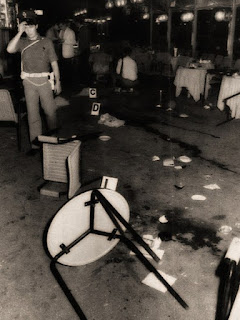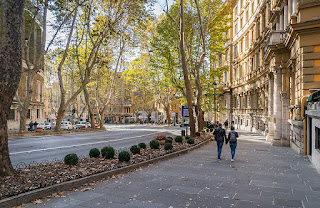NEW - Terror attack on Café de Paris
Grenades thrown into iconic meeting place
The Café de Paris, a hang-out for Rome’s rich and famous during the 1950s and ‘60s and a symbol of the era encapsulated in Fellini’s classic film La dolce vita, was attacked by terrorists on this day in 1985. Tables outside the iconic venue, on the city’s fashionable Via Veneto, were packed with tourists on a busy evening when two grenades were thrown from a passing car or motorcycle. One of the devices, of the classic type known as pineapple grenades, failed to explode, but the other did go off, injuring up to 39 people in the vicinity. Although 20 were taken to hospital, thankfully most were released quickly after treatment for minor wounds. There were no fatalities and only one of those hospitalised, a chef who happened to be waiting on tables at the time of the attack, suffered serious injuries. Most of the victims were reported to be American, Argentine, West German or British tourists enjoying a late evening drink while taking in the atmosphere of Roman nightlife on a street lined with shops, cafés, airline offices and luxury hotels. It was thought that three individuals carried out the attack but only one was apprehended and charged. Read more…
_______________________________________
Sir Anthony Panizzi - revolutionary librarian
Political refugee knighted by Queen Victoria
Sir Anthony Panizzi, who as Principal Librarian at the British Museum was knighted by Queen Victoria, was a former Italian revolutionary, born Antonio Genesio Maria Panizzi in Brescello in what is now Reggio Emilia, on this day in 1797. A law graduate from the University of Parma, Panizzi began his working life as a civil servant, attaining the position of Inspector of Public Schools in his home town. At the same time he was a member of the Carbonari, the network of secret societies set up across Italy in the early part of the 19th century, whose aim was to overthrow the repressive regimes of the Kingdoms of Naples and Sardinia, the Papal States and the Duchy of Modena and bring about the unification of Italy as a republic or a constitutional monarchy. He was party to a number of attempted uprisings but was forced to flee the country in 1822, having been tipped off that he was to be arrested and would face trial as a subversive. Panizzi found a haven in Switzerland, but after publishing a book that attacked the Duchy of Modena, of which Brescello was then part, he was sentenced to death in absentia by a court in Modena. Read more…
_______________________________________
Sette e mezzo: The Palermo revolt of 1866
Insurgents took control of city after a major uprising
The Sette e mezzo revolt - so named because it lasted seven and a half days - began in Palermo, the capital of Sicily, on this day in 1866. The uprising - five years after the island became part of the new Kingdom of Italy - brought to the surface the tensions that existed in southern Italy following the Risorgimento movement and unification. It was put down harshly by the new government of Italy, who laid siege to the city of Palermo, deploying more than 40,000 soldiers under the command of General Raffaele Cadorna. It is not known exactly how many Sicilians were killed before the revolt was subdued. Several thousand died as a result of a cholera outbreak that swept through Palermo and the surrounding area, but it is thought that more than 1,000 may have been killed as a direct consequence of the siege. Sicily did not take well to the imposition of a national government, bringing with it plans to modernise the traditional economy and political system. New laws and taxes and the introduction of compulsory military service caused resentment. There was a feeling also that the industrialisation of Italy was too heavily concentrated in the north, with little investment being made in the south. Read more…
_____________________________________
Paolo Di Lauro - Camorra boss
Capture of mobster struck at heart of Naples underworld
Italy's war against organised crime achieved one of its biggest victories on this day in 2005 when the powerful Camorra boss Paolo Di Lauro was arrested. In a 6am raid, Carabinieri officers surrounded a building in the notorious Secondigliano district of Naples and entered the modest apartment in which Di Lauro was living with a female companion. The 52-year-old gang boss did not resist arrest, possibly believing any charges against him would not be made to stick. However, at a subsequent trial he was convicted and sentenced to 30 years' imprisonment for drug trafficking and other crimes and remains in jail. Di Lauro's conviction was significant because it removed the man who had been at the head of one of the most lucrative criminal networks in all of Italy for more than 20 years and yet managed to maintain such a low profile that police at times suspected he was dead. At its peak, the Di Lauro clan presided over an organisation that imported and distributed cocaine and heroin said to be worth around €200 million per year. The clan essentially controlled the run-down northern suburbs of Naples, making money also from real estate, counterfeit high-end fashion and prostitution. Read more…
_____________________________________
Alessandro Fortis - politician
Revolutionary who became Prime Minister
Alessandro Fortis, a controversial politician who was also Italy’s first Jewish prime minister, was born on this day in 1841 in Forlì in Emilia-Romagna. Fortis led the government from March 1905 to February 1906. A republican follower of Giuseppe Mazzini and a volunteer in the army of Giuseppe Garibaldi, he was politically of the Historical Left but in time managed to alienate both sides of the divide with his policies. He attracted the harshest criticism for his decision to nationalise the railways, one of his personal political goals, which was naturally opposed by the conservatives on the Right but simultaneously upset his erstwhile supporters on the Left, because the move had the effect of heading off a strike by rail workers. By placing the network in state control, Fortis turned all railway employees into civil servants, who were not allowed to strike under the law. Some politicians also felt the compensation given to the private companies who previously ran the railways was far too generous and suspected Fortis of corruption. His foreign policies, meanwhile, upset politicians and voters on both sides. Read more…
______________________________________
Book of the Day: La dolce vita (BFI Film Classics), by Richard Dyer
Fellini's La dolce vita has been a phenomenon since before it was made, a scandal in the making and on release in 1960 and a reference point ever since. Much of what made it notorious was its incorporation of real people, events and lifestyles, making it a documentation of its time. It uses performance, camera movement, editing and music to produce a striking aesthetic mix of energy and listlessness, of exuberance and despair. Richard Dyer's study considers each of these aspects of the film phenomenon, document, aesthetic and argues that they are connected. Beginning with the inspirations and ideas that were subsequently turned into La dolce vita, Dyer then explores the making of the film, the film itself and finally its critical reception, providing engaging new insights into this mesmerising piece of cinema.Richard Dyer is Professor Emeritus of Film Studies at King's College, London, and Professorial Fellow in Film Studies at the University of St Andrews, UK. He has been honoured by the Society for Cinema and Media Studies, the British Association of Film, Television and Screen Studies, and Turku and Yale Universities, and is a Fellow of the British Academy. He is the author of several books.

.jpg)
.jpg)
.jpg)








.jpg)
%20(1).jpg)



.jpg)
.jpg)
